BRICS and G7 are two significant economic and political groups in the world. BRICS comprises Brazil, Russia, India, China, and South Africa, while G7 includes Canada, France, Germany, Italy, Japan, the United Kingdom, the United States, and the European Union. The priorities and approaches of these two groups are different, as their relationship is not explicitly confrontational.
The BRICS nations are characterized by their large populations, rapid economic growth, and increasing influence on the world stage. They offer an alternative bloc for emerging economies that may have struggled with the International Monetary Fund’s structural adjustment and austerity programs.
In contrast, the G7 countries are historically the world’s largest economies. They focus on maintaining their economic hegemony and promoting a rules-based international order. This outline aims to comprehensively compare the two groups in terms of some factors, including economic, geopolitical, and military influence.
Key Statistics: Brics vs G7
BRICS
- Combined GDP (2022): $26.03 trillion
- GDP per country (2021): China ($16.86 trillion), others below $3 trillion
- Share of global GDP (PPP): 31.5%
- Share of global GDP growth (2012-2022): 16%
- Total population: 3.24 billion
- Share of world’s population: 40%
- Share of world’s trade: 16%
- FDI inflow as a percentage of GDP (2017): 2.3%
- FDI inflow growth rate (2010-2015): 59%
G7
- Combined GDP (2022): $45.9 trillion
- GDP growth rate: 1.1%
- Share of global GDP (PPP): 30%
- Share of global GDP growth (2012-2022): 14%
- Total population: 0.8 billion
- Share of world’s population: 10%
- FDI inflow as a percentage of GDP (2017): 1.7%
- Share of global gross national income: 45%
Historical Context: When and Why BRICS-G7 were Formed
The G7 and BRICS are two significant economic blocs representing advanced and emerging economies.
The G7 was formed in 1975 as an informal association of the seven democratic industrialized countries of Canada, France, Germany, Italy, Japan, the United Kingdom, and the United States of America, plus the European Union as a permanent guest. The G7 is a forum to coordinate global policy on major international issues, especially in trade, security, economics, and climate change.
On the other hand, the BRICS, formalized as BRIC, began as an informal grouping of four countries (Brazil, Russia, India, and China) in 2006, resulting from the 1st BRIC Foreign Ministers’ Meeting in September 2006. South Africa was accepted as a full member at the BRIC Foreign Ministers’ meeting in New York in September 2010, and the group was renamed BRICS.
The BRICS countries represent emerging economies. The group aims to promote economic cooperation and development among member countries, as well as to increase their influence in global affairs.
Sources: The Financial Express, Council on Foreign Relations, DW, Wikipedia
Economic Comparison of BRICS vs G7
BRICS and the G7 are groups of major advanced and emerging economies that often get compared due to their significant influence in global economics and politics. Subsequent subsections highlight the economic comparison of the two groups.
Share of Global GDP
As of 20201, the BRICS countries contributed 31.5% of global GDP, while the G7’s share fell to 30%.
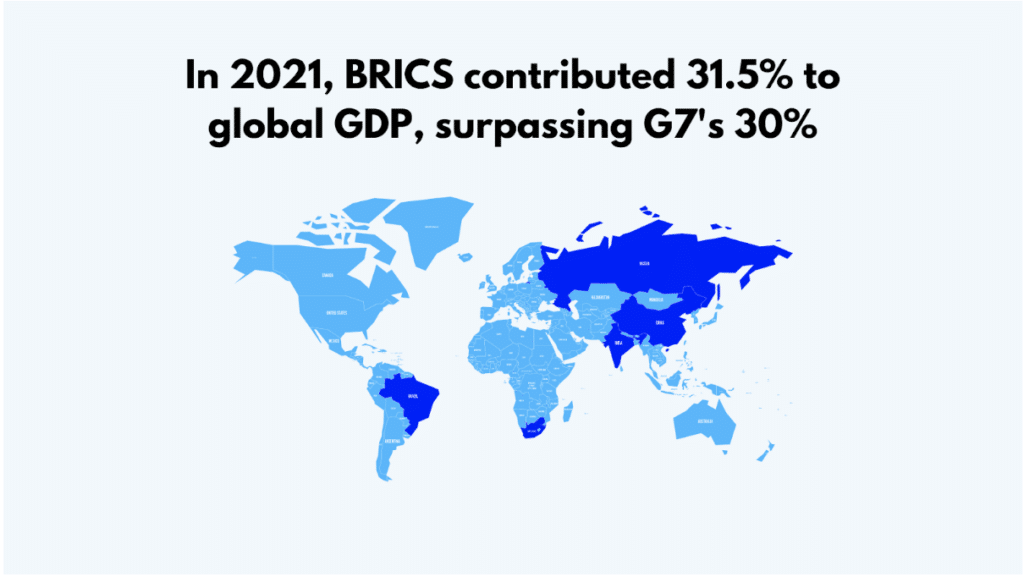
The BRICS nations’ contributions to the global GDP are expected to exceed 50% by 20301.
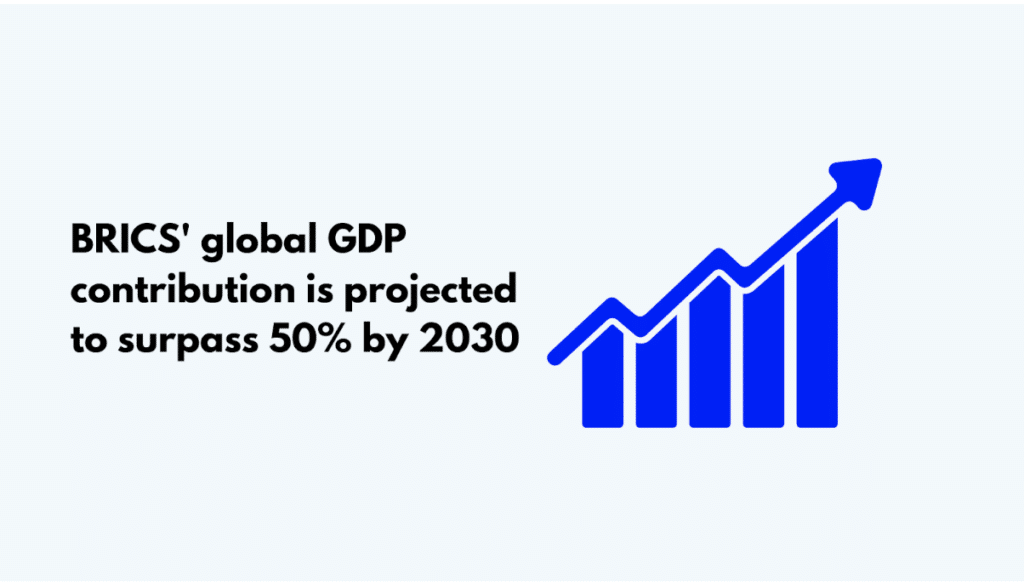
The G7’S nominal global economy contribution is $46 trillion, while the BRICS’ is $27.7 trillion5.
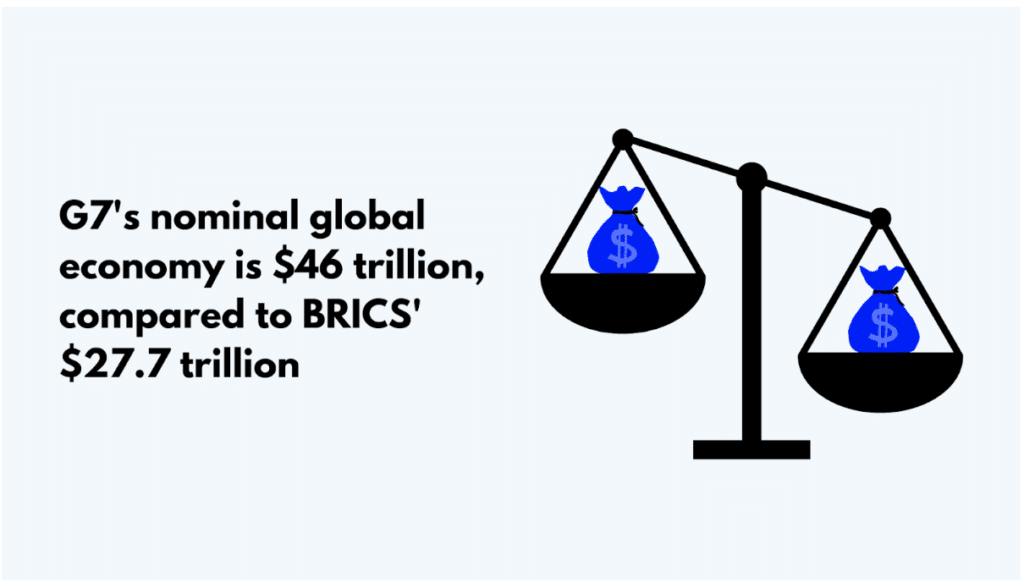
This indicates a shift in economic power from the traditionally dominant G7 countries to the emerging economies of BRICS.
GDP Per Capita
Advanced economies have an average of US$55.542 thousand in GDP per capita, while emerging and developing economies have an average of US$6.672 thousand.
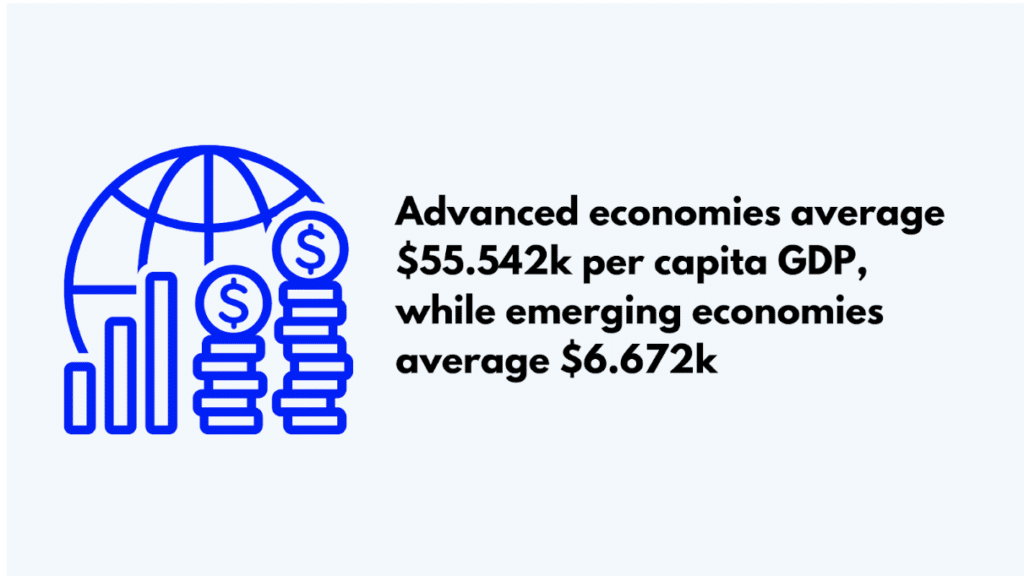
The reasons why the GDP per capita in G7 countries is much higher than in BRICS are mainly due to these:
- G7 comprises advanced economies, while BRICS are emerging and developing economies.
- The population differences are vast. The G7 countries (800 million)3 account for about 10% of the world’s population, while India and China comprise about 35% (BRICS:3.2 billion)3.
However, G7’s GDP per capita is far from the global average (US$13.442 thousand), while the global’s is more than the BRIC’s.
GDP Growth Rates
G7’s contribution to the world economy is predicted to decrease to 27.8% by 2028, while the BRICS will account for 35% in the same year.

In 2020, the contributions from BRICS countries and the G7 to global economic growth were close. However, since that time, the performance of the Western-led bloc has been declining. The strong growth experienced in BRICS nations recently is due to China and India’s performances.
Contribution to Global Economic Growth
According to the latest IMF data4, the BRICS countries will contribute 32.1% of the world’s growth, compared to the G7’s 29.9%.
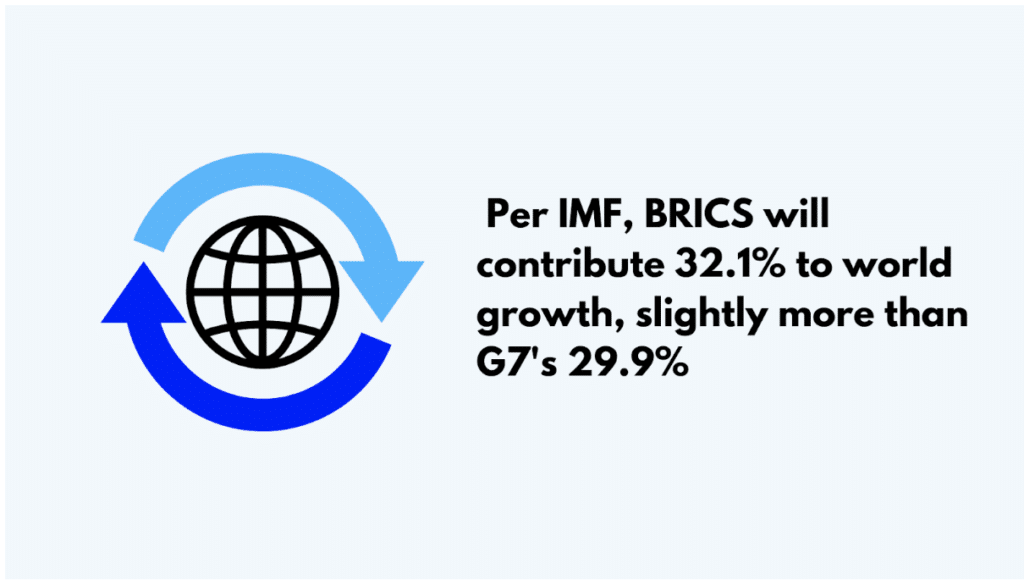
The gap between the two groups regarding global economic weight is expected to grow. As the major drivers, China and India are predicted to continue experiencing robust economic growth.
Sources: TV Brics1, International Monetary Funds2, Twitter3, Business Today4, Visual Capitalist5
Population, Demographics and Landmass of BRICS vs G7
The major outlines of this section analysis are the total populations, age demographics study, and the landmass that combine to make up the BRICS and G7.
Total Population
The BRICS nations have a combined population of approximately 3.24 billion1 people, while G7 countries have around 750.47 million2.
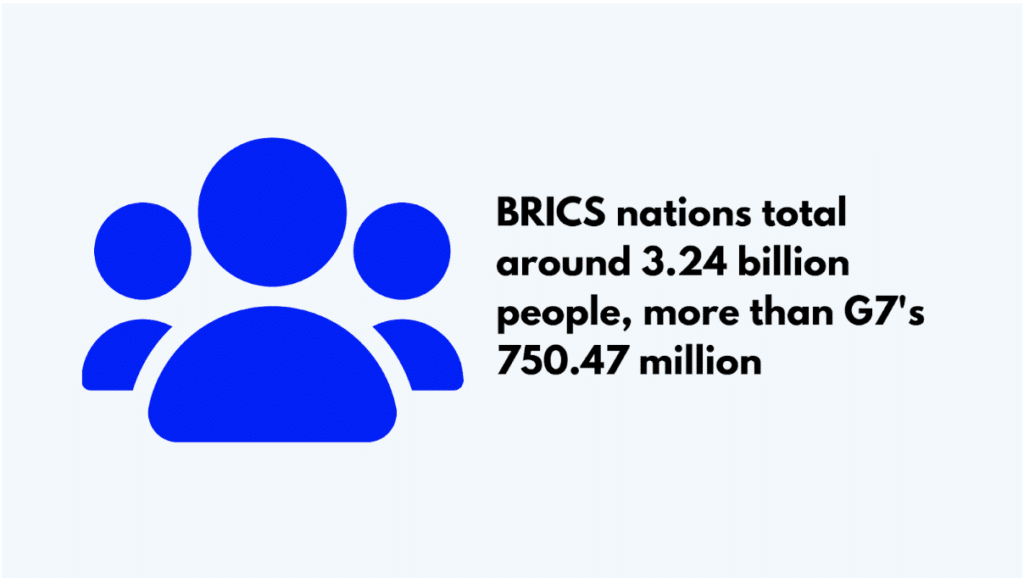
Also, BRICS1 accounts for 40% of the world’s population, while G72 has only about 10% of the world’s population.
Median Age and Age Structure
The median age of countries in G7 and BRICS varies significantly. While Japan has the highest median age in G7’s category, Russia has the oldest among BRICS nations.
We will focus on each category’s statistics to show how they differ.
Table One: G7 Median Age
| G7 Nations | Median Age in Years |
| Japan3 | 48.6 |
| Germany3 | 47.8 |
| Italy3 | 46.5 |
| Canada3 | 41.8 |
| France3 | 41.7 |
| United Kingdom3 | 40.6 |
| United State3 | 38.5 |
| European Union4 | 44.4 |
Table Two: BRICS Median Age
| BRICS Nations | Median Age in Years |
| Russia3 | 40.3 |
| China3 | 38.4 |
| Brazil3 | 33.2 |
| Canada3 | 41.8 |
| India3 | 28.7 |
| South Africa3 | 28.0 |
Landmass
Comparing the BRICS nations with G7 nations, Russia has the highest landmass in KM2, and ranks top. Let’s compare the countries together to see how they all rank.
| BRICS/G7 Nations | Total Areain KM2 |
| Russia5 | 17,098,242 |
| Canada5 | 9,984,670 |
| China5 | 9,706,961 |
| United States5 | 9,372,610 |
| Brazil5 | 8,515,767 |
| India5 | 3,287,590 |
| South Africa5 | 1,221,037 |
| France5 | 551,695 |
| Japan5 | 377,930 |
| Germany5 | 357,114 |
| Italy5 | 301,336 |
| United Kingdom5 | 242,900 |
| European Union5 | 4,233 million |
Generally, the BRICS nations edge the G7s in terms of population and Landmass. However, the average median age of people in the G7 nations edges those in the BRICS’ countries.
Sources: Statista1, National Master2, World Data Info3, European Commision4, Worldmeter5, Google6,
Influence and Geopolitics
When it comes to politics and military powers, BRICS and G7 are two significant economic blocs with different levels of influence in international institutions.
Voting Power and Influence in International Institutions
In international institutions, BRICS countries have pushed for increased representation and voting power. For example, BRICS has successfully lobbied the International Monetary Fund (IMF) for greater voting rights for emerging economies. However, the representation of BRICS countries in influential institutions like the World Trade Organization (WTO), the IMF, and the United Nations (UN) is still uneven compared to G7 countries.
BRICS countries have also established the New Development Bank (NDB). This provides resources to emerging economies with equal voting power and shared stakes for each member. However, this is in contrast to the IMF, where voting power is based on the amount paid as a contribution by each member state. Further adding to the dominance of G7 countries.
G7’s Focus on Security and Containment Strategies
The G7 is committed to ensuring a secure and trustworthy digital future for its nations and the global community by prioritizing cybersecurity. The group’s cybersecurity efforts focus on raising awareness of cyber threats, promoting international cooperation on cybersecurity, building more resilient and secure infrastructure, and developing new technologies to combat cyber threats.
In addition to cybersecurity, the G7 has been focusing on addressing the threat of firearms trafficking and working closely with authorities in conflict areas to establish strict arms control and comprehensive registration regimes. The group also aims to deepen strategic cooperation among its members in countering attacks on and better protecting critical infrastructures.
BRICS as an Alternative Bloc for Emerging Economies
BRICS is a significant geopolitical rival to the G7. The bloc introduced several competing initiatives, including the New Development Bank, the Contingent Reserve Arrangement, the BRICS payment system, the BRICS Joint Statistical Publication, and the BRICS basket reserve currency. They’ve been pushing for increased representation in the IMF, as their combined GDP has surpassed that of the G7.
BRICS offers an alternative bloc for emerging economies that may have struggled with the International Monetary Fund’s structural adjustment and austerity programs. The group challenges the hegemony of the G7 by offering commercial alternatives to create infrastructure for social, economic, and environmental development. These strategies are attractive not only to the bloc but also to other countries that might negotiate with them.
BRICS Challenging G7 Hegemony in International Relations
BRICS challenges the G7’s hegemony in international relations. The growing power of China and Russia is particularly a concern for the G7 countries. The BRICS nations likewise want to position themselves as the representatives of the Global South.
New Development Bank, among other establishments by the BRICS countries, is one of the group’s major achievements they can count on. Also, initiatives like the BRICS currency are to challenge the US dollar’s hegemony and the G7’s overall dominance.
Military Power
G7 countries have a clear upper hand when it comes to military strength. These countries possess advanced sophisticated weapons, aircraft, and higher technology. The G7 also imposed coordinated sanctions on Russia in response to its war in Ukraine and launched a major global infrastructure program to counter China’s Belt and Road Initiative.
While BRICS is not a military alliance like NATO, there are discussions about its potential as a military power. Some experts believe that building military alliances among the BRICS member-states could lead to BRICS becoming the NATO of the Global South. However, as of now, the military capabilities of BRICS countries are not on par with those of the G7 nations.
Sources: CGTN Live, The Loop, CADTM, Socradar, Homeland Security, Wikipedia, InterRegional, Wilson Center, DW, CNBC, Sputnik International, The Explained Post, CFR, The International Magz
Comparisons: BRICS and G7
| Characters | BRICS | G7 |
| Global GDP Share | 31.5% | 30% |
| Nominal Global Economy | $27.7 trillion | $46 trillion |
| GDP Per Capita | $6.67 thousand | $55.54 thousand |
| Predicted Growth Contribution | 32.1% | 29.9% |
| Total Population | 3.24 billion | 750.47 million |
| Highest Median Age | 40.3, Russia | 48.6, Japan |
| Largest Landmass | 17,098,242, Russia | 9,984,670 ,Canada |
| African Member States | One, South Africa | None |
| World Population Share | 40% | 10% |
| GHG Emissions Top 10 Rating | 4 countries | 3 Countries |
Environmental and Sustainability Measures of BRICS and G7
The BRICS and G7 countries have taken several initiatives to address environmental and sustainability issues. We will look at some of the measures taken to address the challenges by the nations involved.
Carbon Emissions
The BRICS nations consume 40%1 of the world’s energy and majorly contribute to CO2 emissions. For example, except for South Africa, all other countries in BRICS feature in the top 102 list of greenhouse gas (GHG) emissions. On the other hand, while G7 nations account for 40%3 of the world’s economic activity, they only account for a quarter of global carbon emissions.
Addressing the Issue
The BRICS Environmentally Sound Technology (BEST) Platform was launched in 20154. It aims to facilitate the accumulation and exchange of experience and information on best available practices and environmentally friendly technologies to achieve Sustainable Development Goals (SDGs). The BEST initiative led to the BRICS countries signing a Memorandum of Understanding on Environmental Cooperation in 20184.
G7 countries are committed to utilizing the G7 Partnership for Global Infrastructure and Investment (PGII) to catalyze public and private finance toward quality climate and energy security investments. Also, the members are working to identify environmental goods, services, and technologies that help combat climate change and coordinate efforts to promote production and trade in those supply chains.
Renewable Energy Usage
BRICS5 nations heavily rely on non-renewable energy sources, such as coal (71%), oil (30%), and natural gas (22%) of the world’s total energy consumption. However, they have been working on increasing their renewable energy consumption.
For example, the BRICS High-level Meeting on Climate Change in 20226 aimed to address climate change, explore approaches to accelerate low-carbon and climate-resilient transition, and achieve sustainable, balanced, and inclusive recovery and development.
The G7 set its first-ever collective targets for the expansion of renewable energy, which include 150 GW of offshore wind capacity and an increase of more than 500 GW of solar capacity by 20307. The bloc also committed to phasing out all fossil fuels.
Sources: Springer Link1, UNEP2, AP News3, BRICS India4, The White House, Science Direct5, Drishtiias6, BXUV7
Future Prospects of BRICS and G7
As we gradually head into the future, we expect some new BRICS and G7 contributions. Below are some expectations.
BRICS Expected to Contribute Over 50% of Global GDP
The BRICS countries are expected to contribute over 50% of global GDP by 20301. Currently, the BRICS nations contribute 31.5% of global GDP, surpassing the G7’s share of 30%. When comparing economies in purchasing parity terms, China’s GDP overtook the United States in 20151. The growth of BRICS economies is expected to continue, with their share of the world economy projected to reach 35% by 20282.
G7’s Contribution to the World Economy Predicted to Decrease to 27.8% by 2028
The G7’s contribution to the world economy will decrease to 27.8% by 20282. In 20202, the contributions from BRICS countries and the G7 to global economic growth were almost equal, but the performance of the Western-led bloc has since been declining. China is expected to be the top contributor to global growth over the next five years, with its share set to be double that of the US.
BRICS Expanding with New Members Joining the New Development Bank
The New Development Bank (NDB), established by BRICS in 2015, continuously expands its membership. In 20213, Bangladesh, the United Arab Emirates, Egypt, and Uruguay joined the NDB. Algeria4 has also formally presented a request to join the BRICS New Development Bank.
The NDB has an initial subscribed capital of US$50 billion and an initial authorized capital of US$100 billion4. The bank has approved about 80 projects in all its member countries, totaling a portfolio of US$ 30 billion4. The expansion of NDB’s membership aligns with its strategy to become the premier development institution for emerging market economies.
Sources: Silk Road Briefing1, Business Today2, New Development Bank3, Wikipedia4,
Conclusion
The BRICS and G7 are two significant intergovernmental groups focusing on economic cooperation between their member countries. While the G7 represents advanced economies, the BRICS group consists of emerging economies, often seen as rivals in the global economic landscape.
When it comes to military strength, the G7 countries have a clear advantage, possessing advanced weapons, aircraft, and technology. However, the BRICS countries represent a larger share of the world’s population and trade and can grow and assert themselves in global politics.

I doubt it’s worth reiterating the twos military prowess. as reigning empires collapsed or declined to the point that they no longer maintained their monetary prominence so did their ability to support their military. if not for the UK’s relationship with the US after the Sterling Pound lost its value England may have took a whole different shape as one the global super powers. Anyway, once the Petrodollar and SWIFT becomes obsolete the US will have bigger things to contend with, European countries will fall into their place quickly, Germany being the first I’m sure.